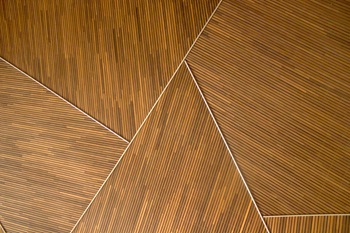Thu Dec 18
Acoustic art: merging functionality with aesthetics
 2025-01-15
IDOPRESS
2025-01-15
IDOPRESS
Acoustic art is an innovative approach to interior design that combines sound-absorbing materials with visually striking artwork. By addressing noise issues and enhancing the aesthetic appeal of a space,acoustic art serves a dual purpose. This article explores the concept of acoustic art,its benefits,applications,and how it is transforming both residential and commercial spaces.
What is acoustic art?

Acoustic art refers to panels or installations that serve as both decorative pieces and sound-absorbing elements. These panels are typically made from materials such as acoustic foam,fabric,or perforated wood,which are designed to reduce noise and control sound reflections. The surface of the panel often features custom artwork,photography,or patterns,turning functional sound control into an artistic statement.
Acoustic art is an ideal solution for spaces where aesthetics and sound quality are equally important. It allows designers and homeowners to address noise issues without compromising on visual appeal.
Benefits of acoustic art
Acoustic art offers numerous advantages that make it a popular choice for modern interiors. It reduces echoes and reverberations,creating a more comfortable acoustic environment. These panels also serve as artistic focal points,enhancing the overall aesthetic of a room. Acoustic art can be tailored to match the decor and style of any space,offering options for custom designs,colors,and materials. Additionally,it provides both practical sound management and decorative value,making it a multi-functional solution.
Applications of acoustic art
Acoustic art is a versatile solution suitable for various settings. In offices,it reduces ambient noise while adding a professional and stylish look. For home interiors,it enhances sound quality in living rooms,home theaters,and bedrooms,doubling as unique decor elements. Restaurants and cafes use acoustic art to control noise levels,creating a more enjoyable dining experience. Educational institutions benefit from improved speech clarity in classrooms and lecture halls,while healthcare facilities achieve a calmer atmosphere for patients and staff. In theaters and studios,acoustic art combines functionality with design sophistication.
Features of acoustic art panels
Acoustic art panels come with features that make them both functional and visually appealing. They often include a sound-absorbing core made from materials like mineral wool or high-density foam,effectively reducing noise. Panels can feature digital prints,hand-painted artwork,or textured patterns,allowing them to suit any interior theme. Many panels are crafted from sustainable materials,appealing to environmentally conscious consumers.
Choosing the right acoustic art
When selecting acoustic art for your space,assess the acoustic needs of the room and choose panels with appropriate sound absorption capabilities. Opt for artwork or patterns that complement the existing decor and ensure the panels are made from durable materials suited to the room’s conditions. Determine whether the panels will be wall-mounted,ceiling-suspended,or freestanding,and balance aesthetics and functionality within your budget.
Maintenance tips for acoustic art
To maintain the appearance and effectiveness of acoustic art,dust the panels gently with a soft brush or vacuum to remove debris. Keep panels dry to prevent damage or warping,and check for wear or damage periodically. Adhere to the care recommendations provided by the manufacturer to ensure longevity.
The art of sound and style
Acoustic art bridges the gap between functionality and aesthetics,offering a solution that manages sound while enhancing interior design. Whether in a bustling office,a cozy home,or a vibrant restaurant,acoustic art provides a harmonious balance of practicality and beauty. By investing in acoustic art,you can create spaces that are both visually inspiring and acoustically comfortable,transforming any environment into a masterpiece of design and functionality.
PM




